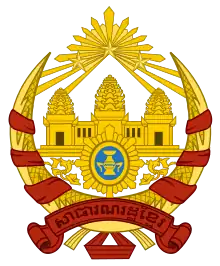| English: March of the Khmer Republic | |
|---|---|
| ដំណើរនៃសាធារណរដ្ឋខ្មែរ | |
 | |
National anthem of the | |
| Adopted | 9 October 1970 |
| Relinquished | 17 April 1975 |
| Preceded by | Majestic Kingdom |
| Succeeded by | 1975: Majestic Kingdom 1976: Victorious Seventeenth of April |
"March of the Khmer Republic"[1] (Khmer: ដំណើរនៃសាធារណរដ្ឋខ្មែរ, Damnaeu ney Satheareanaroat Khmae; French: La Marche de la République Khmère)[2] was the national anthem of the Khmer Republic from 1970 to 1975. The song is often attributed to groups of students, led by Hang Thun Hak, at the Royal University of Fine Arts in Phnom Penh, but academic sources say it was written and composed by the Buddhist monk activist Khieu Chum, a student of Hem Chieu.[3] The song was adopted as the national anthem of the newly founded Khmer Republic on 9 October 1970 after the overthrow of the monarchy. After the end of the Republic due to the Khmer Rouge victory in 1975, the song ceased to be the national anthem and was officially replaced in 1976 by the Khmer Rouge anthem "Victorious Seventeenth of April".
The "enemy" in the first line of the second stanza is a reference to the invasion of Cambodia by the North Vietnamese communists that began on 29 March 1970, just eighteen days after the coup, at the request of the Khmer Rouge's second in command, Nuon Chea, and had completely overrun the northeast of Cambodia by the time the Republic was declared that October.
Lyrics
| Khmer | UNGEGN transcription | French translation | English translation |
ជនជាតិខ្មែរ ល្បីពូកែមួយក្នុងលោក |
Chônchéatĕ Khmêr lôpi pukê muŏy knŏng loŭk |
Les Khmers sont des gens célèbres et habiles dans le monde |
Khmers are famous and skilful people in the world, |
References
- ↑ Press & Information Office, Embassy of the Khmer Republic (1973). "Khmer News. Number 12. April 5, 1974. Page 14". Archived from the original on 2023-05-01. Retrieved 2021-09-24.
- ↑ រ័ត្ន សណ្ដាប់. "ប្រវត្តិទង់ជាតិ ភ្លេងជាតិ នគររាជ. ភ្នុំពេញ: ២០១១". elibraryofcambodia.org. Archived from the original on 2021-09-23. Retrieved 2021-09-24.
- ↑ Harris, Ian (2010). Buddhism as an Element in Cambodian Political Conflict: the Overthrow of Norodom Sihanouk (PDF). Religious Dimensions to Southeast Asian Conflicts Panel, EUROSEAS Conference, University of Gothenburg. Archived from the original (PDF) on 24 September 2015. Retrieved 30 May 2014.